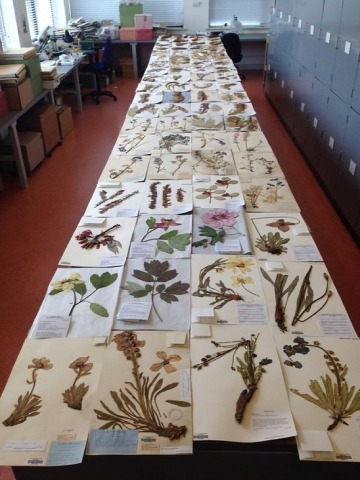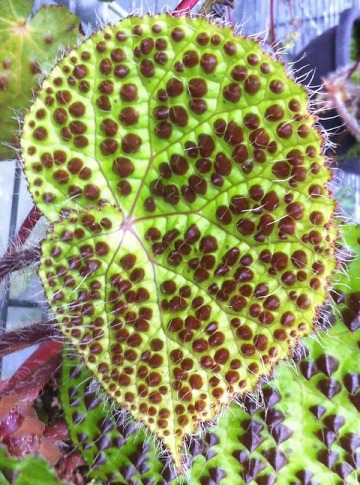Meeting Those Midnight Computing Needs
Papua New Guinea is home to hundreds of Begonia species - possibly one of the fastest radiations of flowering plants. This species is unidentified, but will soon be sequenced using Hyb-Seq by Hannah Wilson as part of her doctoral project at RBGE. The data

Image: RBGE Herbarium.
Catherine Kidner, a senior lecturer in the School of Biological Sciences at the University of Edingburgh, doesn’t remember when she started using CyVerse resources, but it was probably sometime around CyVerse’s inception as the iPlant Collaborative in 2008.
Between teaching at the university, working at the Royal Botanic Garden of Edinburgh (RBGE), and parenting for two teenagers at home, “I have a lot of places to be,” Kidner said, “for me, to be able to have as much computing power as I need in the middle of the night from home is really key.”
From partaking in a little late-night genetic analysis, to suggesting software to graduate students, to testing new approaches for analyzing data, Kidner turns to CyVerse resources.
As a developmental geneticist, Kidner studies how genetics underlie and shape differences between species of plants. She splits her time between teaching at the university and researching at the botanic garden, but when it comes to analyzing transcriptomes of her study specimens, “I’ve found it very useful being able to free myself from institutional computing, which isn’t always set up to do big bioinformatics projects.”

“When my bioinformatics needs exceeded the system, I used to have to go find the IT people and explain why I wanted a different version of software, and it would turn into this big project. Now, to be able to spin up my own instance on CyVerse, install the tools I want, throw it away when I make mistakes – it’s so much more efficient.”
Recently, Kidner and her collaborators (CyVerse makes it easy for her to communicate and collaborate with scientists around the world at any time) used Hyb-Seq to take a peek at the past 187 years of genetic changes in a species called Inga umbelliferae, a tough-leaved tropical tree.
The technique uses RNA baits to select specific, targeted segments of genomic DNA from a sequencing library. Instead of sequencing the whole genome at a low coverage, we can get in-depth sequencing of several hundred genes. It’s ideal for phylogenetics,” Kidner explained. “And,” she added, “it works on degraded DNA as well.”
The RBGE, a nearly 350-year-old public education and research institution housing one of the world’s largest collections of living plants, has a fair amount of degraded DNA in its herbarium. Rows of cupboards of dried plants represent millions of specimens going back hundreds of years, with about 10,000 new specimens added every year.
Kidner and her collaborators, including Michelle Hart, Laura Forrest and James Nicholls at the RBGE, were able to get 130,000 kilobases of DNA sequence from a specimen collected in 1835 in Peru, and compare the genetic sequences to those of trees that have been collected recently.

Kidner easily set up an instance on Atmosphere, CyVerse’s cloud computing platform, to do the analysis. “It’s only a quick look, not population-level sequencing, but we could see functional variation in a pair of duplicate genes which are key regulators of anthocyanin production. Anthocyanin is the main red pigment in plants, with important roles in protection from pathogens and herbivores as well as from damage caused by high light intensity.”
“The things we can do now are really exciting,” said Kidner. “Hyb-Seq opens up collections made over hundreds of years to genetic analysis.” She hopes to examine long-term changes to plant life, such as the impact of the industrial revolution, or changes in farming management. The technique also allows researchers to study the genetics of samples from populations or species that are now extinct.
Begonias are one of Kidner’s primary study systems, a genus consisting of nearly 2,000 species found throughout Earth’s tropical regions, from mountainous regions to drier forests and scrub lands. “There’s an extraordinary amount of diversity, and because they’ve been the focus of much taxonomic work, there is a good phylogenetic knowledge-base to work with.”

“Many Begonias have a very limited distribution, are represented by only a single collection, and at high risk of extinction. As we have herbarium specimens, we have the technology and techniques to sequence extinct species easily. This will enable us to see exactly what genetic diversity is being lost, for example though limestone mining in the Karsts of South East Asia, a center of Begonia diversity.” For her work on Begonias, Kidner collaborates with Yu-Hsin Tseng and Kuo-Fang Chung at Academia Sinica in Taiwan.
But understanding the impacts of mining on Begonia genetics will have to wait. For now, “there’s another group that has come up with a new approach to analyzing Hyb-Seq data called HybPiper,” said Kidner. "It's going to be really easy for me to test that approach and see how it works on our data, because I can just set up an instance on CyVerse."
Upper right: Catherine Kidner, senior lecturer at the University of Edinburgh and researcher at RBGE. (Image courtesy of Catherine Kidner)
Left: Samples of the herbarium collection at RBGE. With roughly 3 million specimens, the collection includes about one-third of the Earth's plant species. The earliest collection dates from 1697. (Image courtesy of RBGE Herbarium)
Lower right: Begonia melanobullata C.-I Peng & C. W. Lin. - One of the Begonias Kidner is studying, along with colleagues from Taiwan. The unusual leaf surface is found in a few other species in Southeast Asia. Hyb-Seq based phylogenetic analysis suggests B. melanobullata evolved independently in different lineages. (Image courtesy of Catherine Kidner)

